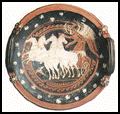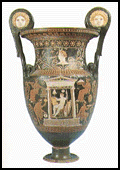The entrance through the south wall leads us to Room 1 where we can find pre-christian antiquities of the wider Greek world.
The exhibits consist mostly of Cypriot ceramics from the Copper Age (c. 2300 B.C,) to Roman times (c. 50 B.C. - 330 A.D.). There
are vessels of various types and uses such as a complex ritualistic red-varnished vessel of the early Copper Age bearing on top a
plank-shaped human figurine framed with two bowls (picture 10). The vessel (D 247) belongs to the same period; round its edges four
fully sculpted birds are affixed as well as an animal-like decanter in the form of a goat (picture 11). From the Cypro-archaic period we
can distinguish a bowl and cup decorated with roses, lotus flowers and full sculpted bull's heads. A group of red-painted and black-painted
vessels from the region of Attica and Graecia Magna round off the exhibition. We mention especially the bowl of the painter of ''Geneva''
(D 211) of the 4th century B.C., another one by the painter "De Santis'' from Graecia Magna with representations of funeral
offerings (picture 15), the tray from the workshop of the ''painter of Baltimore'' of the 4th century B.C. with a representation of
Eos (Dawn) leading a four-horse chariot (picture 14) as well as the Attic black-painted amphora (picture 13) by the "painter of
Antimenos'' (c. 520 B.C.) with main representation that of Theseus killing the Minotaur as well as a four-horse chariot. The
young hero is pictured on the side holding with his left hand the Minotaur's neck while with his right hand he gets ready to
pierce his belly with his lance. The Minotaur, with a bull's head and a man's body with a tail, is pictured on the side half-kneeling
and opposing Theseus. On either side two female figures, Ariadne and the Goddess Athena, with a self-controlled expression are
awaiting the result of the fight. The other side represents a four-horse carriage being steered by a charioteer.
|
 |
| Pict. 14. Tray from Graecia Magna (Apuleia), 4th century B.C. |
 |
| Pict. 15. Krater from Graecia Magna (Southern Italy), 4th century B.C. |
|





